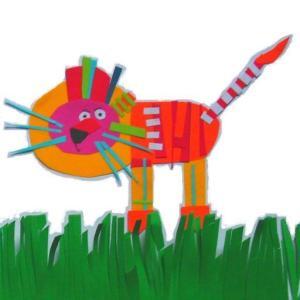Acquarello steineriano – esercizio con blu di prussia, rosso carminio, giallo limone, giallo oro e rosso vermiglio
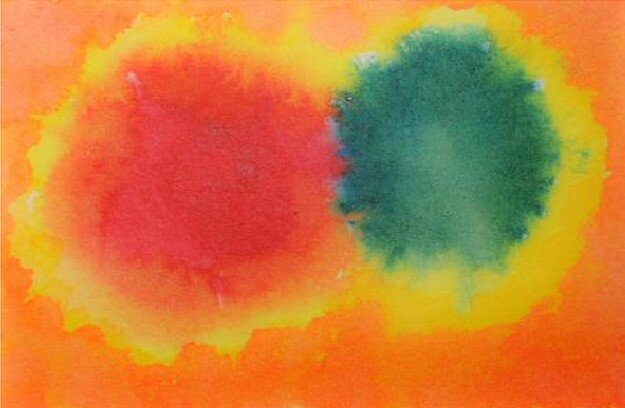
1. entra il blu di prussia, e crea un suo centro sul foglio, espandendosi un poco da suo centro verso la periferia
2. entra il rosso carminio, creando un suo centro accanto al blu ed espandendosi senza toccarlo, fino a diventare grande come lui.
3. entra il giallo limone, che è la loro gioia di stare insieme, e li abbraccia entrambi e poi muovendosi verso il centro di ognuno, li trasforma
4. arriva il giallo oro a fare la corona intorno ai colori, e questa corona d’oro poi espande la sua luce fino a coprire tutto il bianco.
5 entra il rosso vermiglio, che lasciando giallo oro la corona, scalda la luce intorno entrando dall’esterno del foglio verso il giallo oro.

Acquarello steineriano – scopo di questi esercizi
Lo scopo di questi esercizi è quello di far fare ai bambini esperienze guidate del colore, svincolato quanto più possibile dall’elemento della forma.
Per questo si utilizzano acquarelli molto diluiti e si lavora sul foglio di carta bagnato.
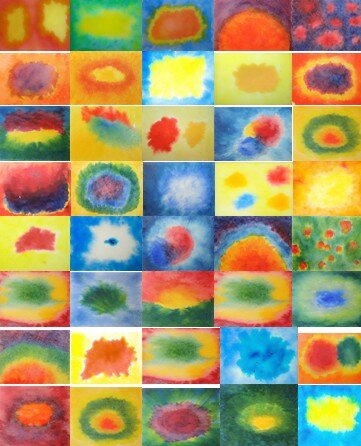
Con l’acquarello steineriano l’esperienza procede rispettando una data sequenza di azioni, che porta il bambino ad affinare la sua sensibilità di percezione del colore e ad acquisire attraverso la pratica le nozioni di colori primari, complementari e secondari. Molto importante è non presentare ai bambini lavori già fatti: vi accorgerete così che proprio chiedendo ai bambini di rispettare una certa sequenza, verrà fuori la personalità di ognuno di loro, e non potranno esserci due pitture uguali, o due verdi uguali, o due marroni uguali ecc…
Importante
La conclusione della lezione viene rimandata al giorno successivo, quando le pitture sono asciutte e vengono esposte una accanto all’altra per essere osservate insieme. L’osservazione, parte integrante della lezione di pittura, può inizialmente essere guidata, poi i bambini saranno in grado di cogliere molti più particolari di quanto non sappiamo fare noi. Si può ad esempio chiedere: “Secondo voi il giallo è più chiaro (più caldo, più freddo, più luminoso, più felice, ecc…) quando è grande o quando è piccolo? Quando è vicino al rosso o quando è vicino al blu?” ecc… E’ importante non solo che imparino ad osservare, ma anche che imparino a descrivere i colori verbalmente. Via via si possono così introdurre i termini tecnici relativi alla teoria dei colori e la nomenclatura appropriata. E’ un lavoro che può cominciare nella scuola d’infanzia, e proseguire in tutti gli anni successivi. Parallelamente, è chiaro, i bambini sperimenteranno anche tutte le altre tecniche (tempera, acrilici, ecc…), con scopi diversi.
Acquarello steineriano: materiale occorrente:
acquarelli di qualsiasi marca in tubetto o flaconcino (non in pastiglia) nei colori: giallo limone, giallo oro, blu oltremare, blu di prussia, rosso vermiglio e rosso carminio. I colori vanno diluiti nei vasetti, in modo che il colore risulti non denso e non carico: diciamo una diluizione abbastanza decisa.
Un pennello a punta piatta largo e con setole di qualsiasi genere, purchè morbide (altrimenti il bambino rischia di graffiare il foglio e noi rischiamo che l’esperienza non venga vissuta come un pieno successo)
una bacinella e un vasetto d’acqua
una spugna che servirà per stendere bene il foglio bagnato sul tavolo, e poi per asciugare il pennello (molto meglio degli straccetti o della carta)
un foglio di carta robusta, meglio se da acquarello (le carte scadenti bagnate possono fare i “pallini”)
Acquarello steineriano: preparazione della lezione
Immergere il foglio nella bacinella,
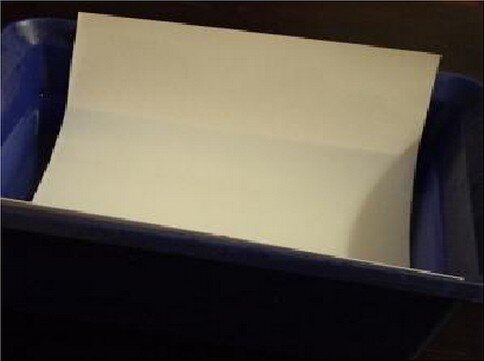
quindi stenderlo con cura sul tavolo con l’aiuto della spugna.
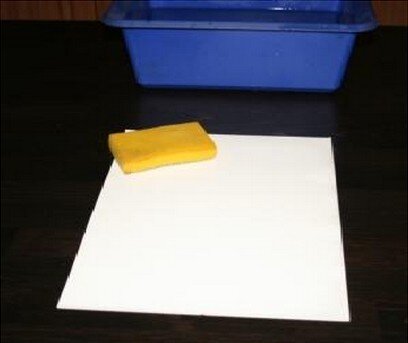
Bisogna evitare che si formino bolle d’aria, perchè altrimenti la carta rischia di arricciarsi.
Poi si dispone il materiale, se volete così:
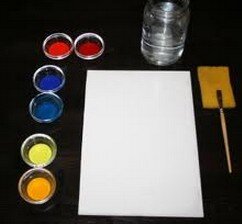
è il modo migliore per evitare incidenti. E si può iniziare…
Acquarello steineriano : qualche consiglio aggiuntivo per homeschooler
In testa ai consigli va quello di prepararsi bene prima di presentare un’attività ai vostri bambini. Se non avete esperienza di pittura ad acquarello, la sera prima, di nascosto, fate voi l’esercizio che volete proporre il giorno dopo.
Altro consiglio è di tenere sempre presente che coi bambini più importante di tutto è che al termine di qualsiasi attività loro si devono sentire più ricchi e più abili, che l’esperienza insomma rappresenti per loro un successo. Non perchè noi diciamo “Ma che bello!”, ma perchè loro stessi si possono stupire della bellezza che possono creare.
Infine ricordate lo scopo dell’attività che volete proporre: nella pittura ad acquarello, ad esempio, uscite dalla logica del voler ottenere un bel prodotto finito. Pensate invece che lo scopo è il processo che ha portato, quasi come effetto collaterale, alla sua realizzazione. Per questo, e anche per “non rovinare la sorpresa” è importante non mostrare ai bambini lavori già fatti prima della lezione.
Preparare con cura il materiale significa anche mettere in tavola solo quello che serve, se ad esempio vogliamo fare un esercizio di rosso e giallo, non mettiamo in tavola anche il blu…
Coi bambini più piccoli, come potrete leggere dagli esempi, è bello guidare l’esperienza facendo in modo che il dipingere sia la storia dei colori che, come veri e propri personaggi, agiscono sul foglio. Questo, naturalmente, se parliamo di bambini piccoli che sanno già seguire lo svolgersi di un racconto.
Se volete invece sperimentare anche prima del raggiungimento di questa tappa evolutiva, vale il principio dell’apprendere per imitazione: si invitano altri bambini a dipingere con lui, oppure ci si siede a dipingere anche noi… parlando pochissimo, e curando tantissimo la preparazione del materiale e la bellezza e precisione dei nostri gesti.
Se preferisci, trovi tutti gli esercizi di colore raccolti in formato ebook qui:
Il contenuto del libro è disponibile inoltre in formato post (consultabile, scaricabile e stampabile) qui: https://www.lapappadolce.net/tag/esercizi-di-colore-steineriani/

Watercolor painting in the Waldorf School tutorial – exercise 19 with golden yellow, lemon yellow, carmine red, vermillion red and Prussian blue.

- Prussian blue comes in, and creates a center on the sheet, spreading out a little from its center to the periphery
- then enters the carmine red, creating a center near the blue and expanding without touching it, until it became as big as him.
- lemon yellow enters: this yellow represents their joy of being together, and embraces them both, and then moving to the center of each one, transforms them
- the golden yellow gets to make the crown, around the colors, and this gold crown then expands its light to cover up all the white.
- red vermilion enters, and without changing the yellow gold of the crown, warm the light around, coming from the outside of the sheet toward the golden yellow.

We propose these watercolor painting exercises to the children, so that they can experience the color in its essence, without ties, as far as possible, with the element of form.
For this reason, we use very diluted watercolors, and paint on wet sheets.
The experience proceeds respecting a sequence of actions that leads the child to sharpen his sensibilities to color perception and to acquire, through practice, the concepts of primary , complementary and secondary colors.
It is very important not to show paintings already made. If we ask the children to follow a certain sequence of actions without showing models, the personality of each child will be free to express, and the result will be surprising because there can be no two alike paintings, or two identical green, or two identical brown, etc. …
Important
The end of the lesson is postponed to the next day, when the paintings are dry and are presented side by side to be viewed together.
The observation is an integral part of the painting lesson. It can initially be guided by the teacher, then the children will be able to recognize many more details of us.
For example, you can ask them: “Do you think the yellow is clearer (hotter, colder, brighter, happier, etc …) when it is large or when it is small? When it is near the red or when it is near the blue? ” Etc. …
It is important that children not only learn to observe, but also they learn to verbally describe the colors. So you can gradually introduce the technical terms related to color theory and the appropriate nomenclature.
It is an activity that can start in kindergarten and continue through all the years to come. In parallel, of course, the children will also experience all the other artistic techniques (painting, acrylics, etc …), with different purposes.

Material required:
– watercolors of any brand in tube or bottle (not tablet) in the following colors: lemon yellow, golden yellow, ultramarine blue, Prussian blue, carmine and vermilion red.
The colors should be diluted in jars. In the Waldorf school we use Stockmar watercolor, which are beautiful, but it is not essential.
– a brush with flat tip and bristle of any kind, provided soft (otherwise the child may scratch the sheet and we risk that the activity is not experienced as a complete success)
– a tub and a jar of water
– a sponge that will serve to smooth out the wet sheet on the table, and then to dry the brush (much better than rags or paper towels)
– a sheet of sturdy paper, the watercolor paper is naturally the best (the shoddy papers, when wet, can form lumps)
How to set up the lesson
Immerse the paper in the tray,

then lay it carefully on the table with the help of the sponge.

You have to avoid the formation of air bubbles, because otherwise the paper may curl.
then have to be put on the table all the necessary material, if you want it this way: it is the best to avoid accidents:

and you can start…
Some additional advice for homeschoolers
– the most important advice is to prepare yourself well before submitting an activity for your children. If you have no experience of watercolor painting, the night before, secretly, do the exercise that you want to propose the next day.
– another tip is to always keep in mind that, with children, it is important that at the end of any activity they must feel enriched and more skilled. The experience must have been for them a success, not because we say, “How wonderful!”, but because they themselves are amazed by the beauty they can create with their hands.
– remember the purpose of the activity that you want to propose: in watercolor painting, for example, outputs from the logic of wanting to get a nice finished product. Think instead that the goal is the process that led, almost as a “side effect”, to its realization. For this reason, and also to “not spoil the surprise” it is important not to show paintings already made by others before the lesson.
– carefully prepare the material means put on the table only what you need: for example, if we want to do an exercise in red and yellow, do not put blue on the table…
– with younger children, as you will read in the examples, it’s nice that the adult directs the experience describing the colors as real characters in a fairy tale, which move on the paper. This, of course, when it comes to small children who already know how to follow the stories.
– if instead you want to experience these activities even before the child has reached this stage of development, you can do so taking advantage the ability of young children to “learn by imitation.” Inviting other older children to paint with him, or you sit down to paint with him. While you paint speak very little, and pay close attention to the preparation of the material and the beauty and precision of our gestures.
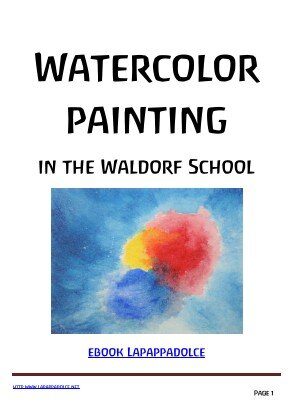
All the exercises are collected in this ebook, if you want:
The content of the book is also available in post format (available for downloading and printing) here:
https://www.lapappadolce.net/tag/esercizi-di-colore-steineriani/

